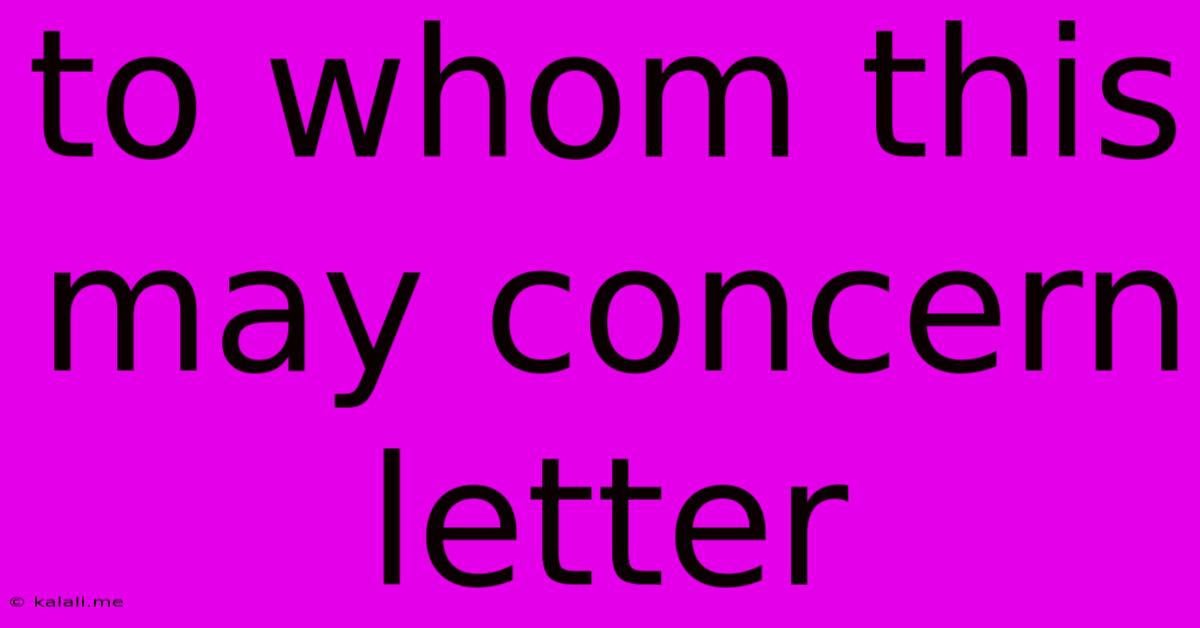To Whom This May Concern Letter
Kalali
May 25, 2025 · 3 min read

Table of Contents
To Whom It May Concern: A Comprehensive Guide to Writing Effective Letters
Meta Description: Learn how to write a compelling "To Whom It May Concern" letter that gets results. This guide covers everything from formatting and tone to addressing specific situations and maximizing your impact. Master the art of writing effective letters for various purposes.
Writing a letter addressed "To Whom It May Concern" might seem impersonal, but it remains a surprisingly effective way to communicate in various professional and personal contexts. While email is often preferred, a well-crafted letter can convey seriousness, formality, and leave a lasting impression. This guide will walk you through crafting a compelling "To Whom It May Concern" letter, ensuring it's both effective and professional.
Understanding When to Use a "To Whom It May Concern" Letter
This salutation is best used when you:
- Don't know the recipient's name: This is the most common reason. If you're applying for a job and don't have a specific contact person, or writing a general inquiry to a company, this is appropriate.
- Addressing a large group: When sending a letter to an organization or department, rather than a single individual.
- Maintaining formality: This salutation maintains a formal tone, suitable for official communications.
However, it's crucial to note that while sometimes necessary, it's generally better to personalize your letter by finding the correct contact person. A personalized letter shows initiative and increases your chances of a positive response.
Crafting Your "To Whom It May Concern" Letter: A Step-by-Step Guide
1. The Heading: Start with your contact information (name, address, phone number, email) at the top left. Below this, include the date. On the right, include the recipient's organization's address.
2. The Salutation: Use "To Whom It May Concern" followed by a colon.
3. The Body: This is the most crucial part. Remember to:
- Be concise and clear: Get straight to the point, avoiding unnecessary jargon or overly flowery language.
- State your purpose early: Clearly explain the reason for your letter in the opening paragraph.
- Provide context: Offer relevant background information to support your request or inquiry.
- Maintain a professional tone: Use formal language and avoid slang or informal expressions.
- Proofread meticulously: Errors undermine credibility. Carefully review for grammar, spelling, and punctuation errors before sending.
4. The Closing: Choose a professional closing, such as "Sincerely," "Respectfully," or "Regards," followed by your signature and typed name.
Examples of Effective "To Whom It May Concern" Letters
A. Job Application: This would clearly state your interest in the position, highlighting your relevant skills and experience. It should also mention where you saw the job advertised. Remember to attach your resume.
B. Complaint Letter: This needs to clearly describe the problem, including specific details and dates. It should also outline the desired resolution. Maintain a calm and professional tone, even when expressing dissatisfaction.
C. Inquiry Letter: This should clearly state your question or request for information. Be specific and polite, ensuring you've done some preliminary research before reaching out.
Maximizing Your Letter's Impact
- Use high-quality paper: A well-presented letter demonstrates professionalism.
- Consider a professional font: Choose a clear and easy-to-read font, such as Times New Roman or Arial.
- Keep it concise: Brevity is key; avoid rambling or unnecessary details.
- Follow up: If you haven't received a response within a reasonable timeframe, a follow-up is appropriate.
While a "To Whom It May Concern" letter might seem less personal than a letter addressed to a specific individual, it can still be highly effective when used appropriately. By following these guidelines, you can craft a professional and compelling letter that achieves your desired outcome. Remember to always prioritize clarity, professionalism, and meticulous proofreading.
Latest Posts
Latest Posts
-
On My End Or In My End
May 25, 2025
-
Minecraft Failed To Login Invalid Session
May 25, 2025
-
The Old Testament Is The New Testament Concealed
May 25, 2025
-
Kill All Processes Of A User
May 25, 2025
-
How Long Does Clamato Juice Last After Opening
May 25, 2025
Related Post
Thank you for visiting our website which covers about To Whom This May Concern Letter . We hope the information provided has been useful to you. Feel free to contact us if you have any questions or need further assistance. See you next time and don't miss to bookmark.